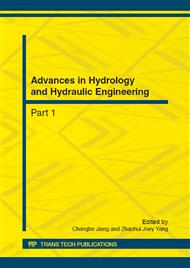p.145
p.151
p.155
p.163
p.169
p.177
p.181
p.186
p.193
Study on Relationship between Sediment Transport and Excess Pore Water Pressure under Regular Breaking Wave Action
Abstract:
Based on the wave flume experiments, the response of excess pore water pressure was studied under the regular breaking wave action on a 1:30 slope sandy seabed. The topographic change was observed in the wave broken zone and its causes were analyzed. The results show that the variation gradient of excess pore water pressure are larger in the surface layer and the changing amplitude of variation gradient of excess pore water pressure is bigger in the wave broken zone. The water depth is the most influential factor of excess pore water pressure and the wave height and period has little influence on excess pore water pressure in the same wave steepness range in the wave broken zone. The topographic change is greatly in the wave breaking zone. Excess pore water pressures changing amplitude at the top are significantly higher than it at the bottom. When the seabed scours, the amplitude of the excess pore water pressure increases; and when the sand seabed accumulates, the amplitude of the excess pore water pressure decreases.
Info:
Periodical:
Pages:
169-176
Citation:
Online since:
October 2012
Authors:
Price:
Сopyright:
© 2012 Trans Tech Publications Ltd. All Rights Reserved
Share:
Citation:


